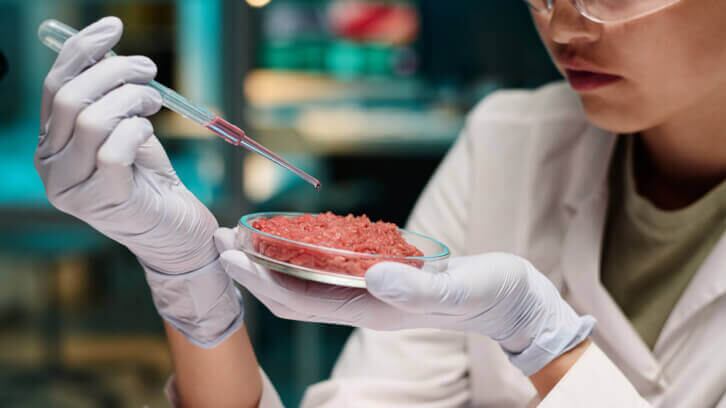Cyanobacteria is a potentially sustainable medium, but more research is needed for bioreactor design
Hanna Tuomisto’s 2011 research at the University of Helsinki explored the role of cyanobacteria as a source of nutrients in cultured meat production (in contrast to the more popular amino acid and glucose sources).
The initial results were positive “in terms of producing biomass per unit of land area compared to crops.” As opposed to glucose, which is produced from agriculture crops like corn or sugar cane, and requires land, cyanobacteria “has very low land use requirements,” she said.
However, with a follow up 2013 study in collaboration with the University of Bath, which examined a more “proper bio reactor design,” Tuomisto noted that lifecycle assessment (LCA) results indicated that “energy use was quite high” due to the use of one type of bioreactor.
Yet, Tuomisto is optimistic that a lower LCA is possible, citing the need for more studies to explore the impact of different types of bioreactors, cells and medium ingredients, among others.
“What our paper showed is that there is potential for cultured meat to have lower environmental impacts, especially compared to beef and maybe pork,” she said.
Tuomisto continued, “If we can use green or low-emission electricity and energy in the production that also lowers the environmental impact, but then also sourcing of the nutrients depending on where they come from, [which] affects the environmental impacts.”
Ultimately, the panel suggested that cultured meat may have lower environmental impacts than conventionally raised meat, but more studies are needed to confirm particularly around LCA for media composition, purity and grid energy.
There is a need for accurate modeling of these factors to ensure a sustainable trajectory for the industry, particularly in terms of energy use and renewable energy sources.
‘Data and assumptions matter in these studies’
Nicole Tichenor Blackstone, Tufts University, explores LCA and AI-based optimization for cell cultivated chicken and beef with a grant from USDA.
Blackstone underscores Tuomisto’s recommendation for better data, citing that her lab is using primary “data from cultivated chicken cells … and cultivated meat cells” from multiple collaborating labs.
Citing the UC Davis preprint—a paper that has not yet undergone a peer review, Blackstone noted—which estimated that lab grown beef would be 25 times worse for the environment than conventional beef, she emphasized that the estimated carbon impact is based on “a worst case scenario.”
The report’s findings, she said, are based on resource-intensive processes. The preprint reports that the serum-free culture medium, Essential 8, which costs $378/liter and requires “1200 liters of media to produce a kilogram of cultivated meat,” is cost-prohibitive.
She added, “Your media use efficiency is going to really affect the final carbon footprint or environmental performance of the product.”
The report also outlined a 20x Impact Factor, which measures the media’s effectiveness in the meat cultivation process, and runs the risk of overestimating the potency of the media. Additionally, Blackstone notes that the study used pharmaceutical-grade ingredients, which may not be necessary and could contribute to increased costs or resource usage.
Blackstone emphasized the role of exploring different growth mediums, some of which “have a high level of purity required for the pharmaceutical industry” and will “have really high environmental impacts,” preventing commercialization in the future.
“When we’re modeling systems like this, it’s really important to feel confident in the level of purity that you’re modeling for different ingredients because it’s going to dramatically affect the environmental performance of the results.”
She also added that it’s critical to factor in the amount of energy powering the facilities is and the importance of renewable and green electricity.
She emphasized that the study is not “a fair scenario” and instead suggest that it’s more useful to the findings as an “illustrative example of why data and assumptions matter in these studies.”
Blackstone added, “As we think of the development of the industry, the development of research, these are things we really need to be paying attention to, to ensure that we’re on a sustainable trajectory and we’re innovating towards sustainability and cost efficiency.”

